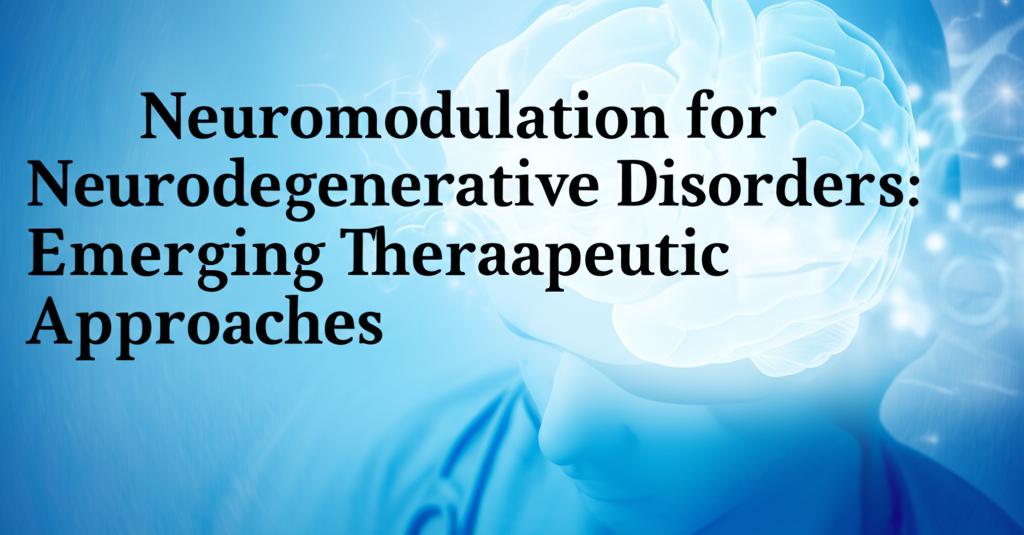Neuromodulation techniques are offering new hope for treating neurodegenerative disorders like Alzheimer's disease, Parkinson's disease, and Huntington's disease, which often lack effective disease-modifying treatments. These approaches aim to modulate neural activity in targeted brain regions, offering potential for both symptomatic relief and, in some cases, slowing disease progression.
Non-Invasive Brain Stimulation (NIBS) Techniques:A significant area of research focuses on non-invasive brain stimulation (NIBS) methods due to their favorable safety profiles. These include:
- Repetitive Transcranial Magnetic Stimulation (rTMS): This is one of the most investigated NIBS techniques, particularly for Alzheimer's disease. It uses magnetic fields to induce electrical currents in specific brain regions. Studies suggest rTMS can have favorable effects on cognitive functions, including global cognition and memory, in Alzheimer's patients, often targeting areas like the dorsolateral prefrontal cortex (DLPFC). It is already approved for conditions like resistant depression. While promising for Alzheimer's, evidence levels are still developing. For Parkinson's disease, rTMS, especially high-frequency rTMS over motor cortical regions, has shown potential in improving motor symptoms and may have antidepressant effects.
- Transcranial Electrical Stimulation (tES): This category encompasses techniques like:
Transcranial Direct Current Stimulation (tDCS): This method passes a weak electrical current between electrodes on the scalp to modulate neuronal activity. It's being explored for cognitive enhancement in Alzheimer's and for motor and non-motor symptoms in Parkinson's. Anodal tDCS over the cerebellum has shown promise in improving motor scores in Huntington's disease.
Transcranial Alternating Current Stimulation (tACS): This technique uses oscillating electrical currents and is being investigated for its ability to modulate brain rhythms and enhance cognitive functions in Alzheimer's.
* Transcranial Temporal Interference Electrical Stimulation (tTIS): A newer technique that allows for targeting deeper brain structures, like the hippocampus, non-invasively. This could be particularly beneficial for cognitive processing in Alzheimer's and has shown promise in enhancing spatial navigation.
- Transcranial Focused Ultrasound (tFUS) / Low-Intensity Focused Ultrasound (LIFU): This emerging technique uses ultrasound waves to modulate neural activity. It offers the unique advantage of being able to target deep brain structures with high focal precision, non-invasively. tFUS is being investigated for its potential in Alzheimer's (including clearing amyloid-beta accumulations when combined with microbubbles), Parkinson's disease (improving motor symptoms and potentially non-motor symptoms), and other neurological conditions. Research is also exploring its use for enhancing drug delivery to the brain by temporarily opening the blood-brain barrier.
- Photobiomodulation (PBM): Also known as low-level light therapy, PBM uses light (often infrared or near-infrared) to stimulate cellular activity. It's an area of growing interest for Alzheimer's and Parkinson's disease.
- Sensory Stimulation: This involves using visual or auditory stimuli, often at specific frequencies (like 40 Hz gamma frequency), to induce brain rhythms associated with healthy brain activity. This approach is showing promise in Alzheimer's disease research, with studies indicating potential improvements in pathology, cognition, and behavior in animal models and early human trials.
- Transcutaneous Vagus Nerve Stimulation (tVNS): This non-invasive technique stimulates the vagus nerve through the skin, which can modulate neural circuits involved in motor control, cognition, and mood. It is being explored for Parkinson's disease.
While NIBS is rapidly advancing, invasive techniques remain important, particularly for more severe or treatment-resistant symptoms:
- Deep Brain Stimulation (DBS): DBS is an established and effective neuromodulatory therapy for Parkinson's disease, primarily targeting motor symptoms. It involves surgically implanting electrodes in specific brain areas. Advances in DBS technology include imaging-guided planning, leads with sensing capabilities, closed-loop (adaptive) stimulation that responds to a patient's real-time brain activity, and directional leads for more precise current delivery. DBS is also being explored for other conditions like Alzheimer's and epilepsy, and research continues to investigate new anatomical targets.
- Personalization: A significant trend is the move towards personalized treatment strategies. This involves tailoring stimulation parameters and targets based on individual patient characteristics, including their specific symptoms, disease progression, genetic background, and brain imaging data (like dMRI and fMRI).
- Understanding Mechanisms: While many neuromodulation techniques show promise, the exact mechanisms by which they exert their therapeutic effects are still being investigated. Further research is crucial to fully understand these mechanisms.
- Clinical Trial Evidence: Many emerging neuromodulation approaches have promising preliminary results, often from small clinical trials. Larger, more robust studies are needed to definitively establish their efficacy, safety, long-term effects, and cost-effectiveness across different neurodegenerative disorders.
- Combination Therapies: Future treatments may involve combining neuromodulation techniques with other therapeutic approaches, such as pharmacological treatments or gene therapy. For instance, implantable drug infusion systems are being developed to deliver therapies like siRNA directly to the brain for conditions like Huntington's disease.
- Technological Advancements: The field is continually evolving with new technologies and protocols, aiming to improve the precision, efficacy, and applicability of neuromodulation. This includes developing less invasive methods and refining existing ones.
Overall, neuromodulation represents a rapidly advancing frontier in the treatment of neurodegenerative disorders. While much research is still needed, these emerging therapeutic approaches offer considerable hope for improving the lives of individuals affected by these challenging conditions.

